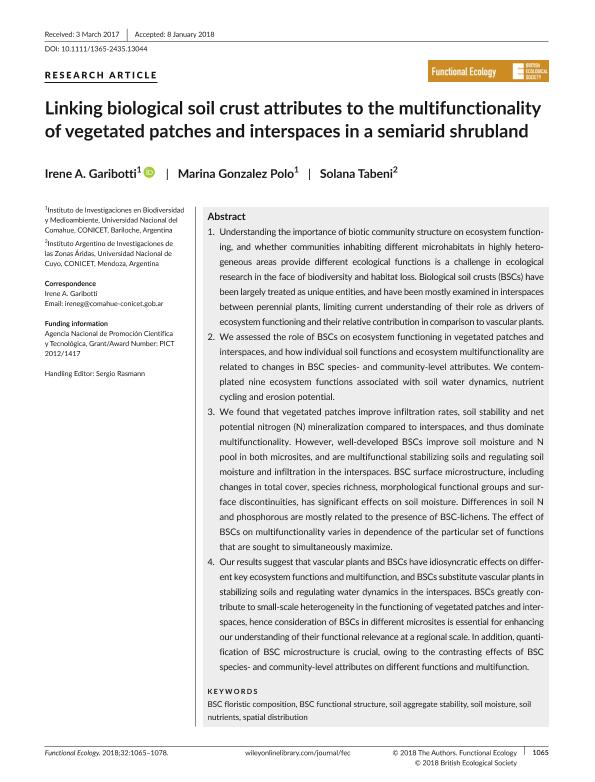Mostrar el registro sencillo del ítem
dc.contributor.author
Garibotti, Irene Adriana

dc.contributor.author
Gonzalez Polo, Marina

dc.contributor.author
Tabeni, Maria Solana

dc.date.available
2019-10-21T20:06:44Z
dc.date.issued
2018-04
dc.identifier.citation
Garibotti, Irene Adriana; Gonzalez Polo, Marina; Tabeni, Maria Solana; Linking biological soil crust attributes to the multifunctionality of vegetated patches and interspaces in a semiarid shrubland; Wiley Blackwell Publishing, Inc; Functional Ecology; 32; 4; 4-2018; 1065-1078
dc.identifier.issn
0269-8463
dc.identifier.uri
http://hdl.handle.net/11336/86735
dc.description.abstract
Understanding the importance of biotic community structure on ecosystem functioning, and whether communities inhabiting different microhabitats in highly heterogeneous areas provide different ecological functions is a challenge in ecological research in the face of biodiversity and habitat loss. Biological soil crusts (BSCs) have been largely treated as unique entities, and have been mostly examined in interspaces between perennial plants, limiting current understanding of their role as drivers of ecosystem functioning and their relative contribution in comparison to vascular plants. We assessed the role of BSCs on ecosystem functioning in vegetated patches and interspaces, and how individual soil functions and ecosystem multifunctionality are related to changes in BSC species- and community-level attributes. We contemplated nine ecosystem functions associated with soil water dynamics, nutrient cycling and erosion potential. We found that vegetated patches improve infiltration rates, soil stability and net potential nitrogen (N) mineralization compared to interspaces, and thus dominate multifunctionality. However, well-developed BSCs improve soil moisture and N pool in both microsites, and are multifunctional stabilizing soils and regulating soil moisture and infiltration in the interspaces. BSC surface microstructure, including changes in total cover, species richness, morphological functional groups and surface discontinuities, has significant effects on soil moisture. Differences in soil N and phosphorous are mostly related to the presence of BSC-lichens. The effect of BSCs on multifunctionality varies in dependence of the particular set of functions that are sought to simultaneously maximize. Our results suggest that vascular plants and BSCs have idiosyncratic effects on different key ecosystem functions and multifunction, and BSCs substitute vascular plants in stabilizing soils and regulating water dynamics in the interspaces. BSCs greatly contribute to small-scale heterogeneity in the functioning of vegetated patches and interspaces, hence consideration of BSCs in different microsites is essential for enhancing our understanding of their functional relevance at a regional scale. In addition, quantification of BSC microstructure is crucial, owing to the contrasting effects of BSC species- and community-level attributes on different functions and multifunction. A plain language summary is available for this article.
dc.format
application/pdf
dc.language.iso
eng
dc.publisher
Wiley Blackwell Publishing, Inc

dc.rights
info:eu-repo/semantics/openAccess
dc.rights.uri
https://creativecommons.org/licenses/by-nc-sa/2.5/ar/
dc.subject
BSC FLORISTIC COMPOSITION
dc.subject
BSC FUNCTIONAL STRUCTURE
dc.subject
SOIL AGGREGATE STABILITY
dc.subject
SOIL MOISTURE
dc.subject
SOIL NUTRIENTS
dc.subject
SPATIAL DISTRIBUTION
dc.subject.classification
Ecología

dc.subject.classification
Ciencias Biológicas

dc.subject.classification
CIENCIAS NATURALES Y EXACTAS

dc.title
Linking biological soil crust attributes to the multifunctionality of vegetated patches and interspaces in a semiarid shrubland
dc.type
info:eu-repo/semantics/article
dc.type
info:ar-repo/semantics/artículo
dc.type
info:eu-repo/semantics/publishedVersion
dc.date.updated
2019-10-10T13:46:17Z
dc.journal.volume
32
dc.journal.number
4
dc.journal.pagination
1065-1078
dc.journal.pais
Reino Unido

dc.journal.ciudad
Londres
dc.description.fil
Fil: Garibotti, Irene Adriana. Consejo Nacional de Investigaciones Científicas y Técnicas. Centro Científico Tecnológico Conicet - Patagonia Norte. Instituto de Investigaciones en Biodiversidad y Medioambiente. Universidad Nacional del Comahue. Centro Regional Universidad Bariloche. Instituto de Investigaciones en Biodiversidad y Medioambiente; Argentina
dc.description.fil
Fil: Gonzalez Polo, Marina. Consejo Nacional de Investigaciones Científicas y Técnicas. Centro Científico Tecnológico Conicet - Patagonia Norte. Instituto de Investigaciones en Biodiversidad y Medioambiente. Universidad Nacional del Comahue. Centro Regional Universidad Bariloche. Instituto de Investigaciones en Biodiversidad y Medioambiente; Argentina
dc.description.fil
Fil: Tabeni, Maria Solana. Consejo Nacional de Investigaciones Científicas y Técnicas. Centro Científico Tecnológico Conicet - Mendoza. Instituto Argentino de Investigaciones de las Zonas Áridas. Provincia de Mendoza. Instituto Argentino de Investigaciones de las Zonas Áridas. Universidad Nacional de Cuyo. Instituto Argentino de Investigaciones de las Zonas Áridas; Argentina
dc.journal.title
Functional Ecology

dc.relation.alternativeid
info:eu-repo/semantics/altIdentifier/doi/http://dx.doi.org/10.1111/1365-2435.13044
dc.relation.alternativeid
info:eu-repo/semantics/altIdentifier/url/https://besjournals.onlinelibrary.wiley.com/doi/abs/10.1111/1365-2435.13044
Archivos asociados
